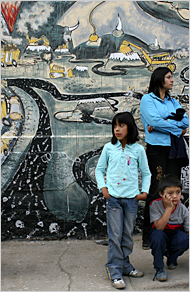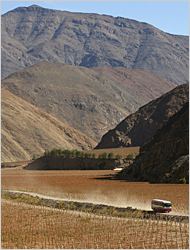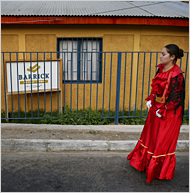|
|
|
|
Proyecto Minero Pascua Lama
- - Mineras en Argentina
Fuente:
www.nytimes.com
30 de julio del 2006
So Much Gold, but Andean Farmers See Big Risks, Too
By LARRY ROHTER
Published: July 30, 2006 -
Versión en español
ALTO DEL CARMEN, Chile — There is gold in these hills — at least $11.5 billion worth at last count, in a wind-swept area studded with glaciers, more than 15,000 feet up in the Andes. The world’s biggest gold company wants to mine it, but is finding that a harsh terrain is not the only obstacle in its path.
Though the Chilean government has tentatively approved the $1.5 billion mining project, called Pascua-Lama, opposition here in Huasco Province is intense and growing.

Tomas Munita for The New York Times
A mural in Alto del Carmen reflects fears that a proposed gold mine could harm the water supply. Barrick Gold says the mine it plans would be safe.
|
Local environmental and civic groups contend that the proposed mine will allow the Barrick Gold Corporation of Canada, which has recently become the world’s largest gold company, to harm the local water supply, destroy agriculture and walk away without paying taxes or royalties.
“As residents of the Huasco Valley, our interest is maintaining a permanent ecological balance so that people and farming can develop and prosper,” said Mauricio Ríos, president of the Committee for the Defense of the Huasco Valley, a civic group in Vallenar, the provincial capital. “Barrick wants to make as much money as possible in 20 years and then leave,” he added. “So what do we gain? They say they are going to create jobs, but at what cost?”
Barrick has responded by emphasizing that it has taken steps beyond those required under Chilean law to ensure that the environment is not damaged and the water supply is protected. It says the mine will bring jobs and development.
“It still puzzles me why there is so much controversy,” said Ron Kettles, the Pascua-Lama project manager. “This is far and away the safest and most environmentally sensitive project that I’ve ever built in 40 years in this business.”
At a time when the price of gold has risen sharply — it has more than doubled in less than five years, and is now at $635 an ounce — the stakes for Barrick are enormous. In a 2004 legal filing in Canada, the company says that Pascua-Lama, which also contains silver deposits worth an estimated $7.5 billion and some copper, represents “approximately 25 percent of Barrick’s worldwide gold reserves.”
 Tomas Munita for The New York Times
Tomas Munita for The New York Times
A bus takes workers to vineyards in Huasco Valley, where the hills contain at least $11.5 billion worth of gold.
|
But the stakes are just as high for local people, who will be here long after the mine closes and who depend on agriculture and runoff from the highlands for drinking water and irrigation in an otherwise parched region.
Home to 70,000 people, the Huasco Valley is a narrow ribbon of green that flows from the Andes west to the Pacific Ocean, just south of the world’s driest desert, the Atacama. Thanks to skillful irrigation, local farmers, including some who belong to the Diaguita indigenous group, have become successful exporters of grapes, avocados, olives, guavas and even mangoes to the United States, Japan and Europe.
What Barrick proposes is to carve a huge canyon, about a mile wide and about 2,000 feet deep, at the Pascua-Lama mine, which stretches over the border into Argentina. The ore would then be crushed and milled and the gold extracted using chemicals that include cyanide. Environmental groups and farmers have expressed concerns that the operations will end up tainting and diverting the local water supply.
“What the government is doing doesn’t make any sense,” said David Martínez Campillay, who has a small grape farm in the community of Chinguito near here. “Chile used to be known only as a mining country,” he added, “and so we were encouraged to branch into new areas of agriculture so that our country could export different products, like fruit. We did that, and now what does the government do? It favors a project that is only going to be here 20 years.”

Tomas Munita for The New York Times
During a celebration honoring the Virgin of Carmen, a local woman danced along a street in Alto del Carmen, in front of the offices of Barrick Gold's Pascua-Lama project.
|
Barrick complains that its opponents are using scare tactics to mobilize the local population. It says the project will include safety measures like channels to divert water away from acidic waste rock and the construction of 34 stations to monitor water quality.
“Cyanide is used in all kinds of industrial applications worldwide and needs to be transported, handled and managed in a safe and responsible manner,” Vincent Borg, a Barrick spokesman, said in a telephone interview from the company’s headquarters in Toronto. “Barrick has an exemplary record and has never had any major incidents involving cyanide.”
| |